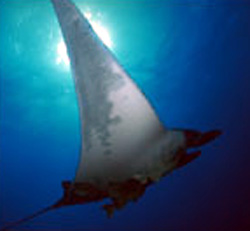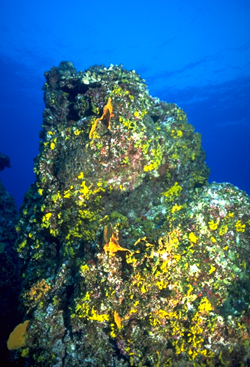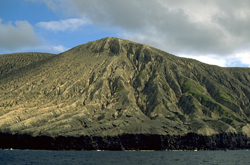Socorro Islands
Isolated in the Pacific waters 225 miles south of Cabo San Lucas Baja and 400 miles west of Guadilahara is the Archipelago de Revillagigedo also known by the largest island, Socorro. This group of uninhabited islands affords spectacular pinnacle diving, large friendly Manta Rays and the unexpected visit by schools of Hammerhead sharks, Whale sharks and the occasional Humpback Whale.
Socorro Islands--The Manta Playground
 Life in today's world has gotten so complex that our lives are filled with a multitude of experiences many routine and many not pleasant. As we day dream out our office window we long for a place and a time where the worries of life fade to a memory and we live the full excitement of the natural world.
Life in today's world has gotten so complex that our lives are filled with a multitude of experiences many routine and many not pleasant. As we day dream out our office window we long for a place and a time where the worries of life fade to a memory and we live the full excitement of the natural world.
Isolated in the Pacific waters 225 miles south of Cabo San Lucas Baja and 400 miles west of Guadilahara is the Archipelago de Revillagigedo also known by the largest island, Socorro. This group of uninhabited islands affords spectacular pinnacle diving, large friendly Manta Rays and the unexpected visit by schools of Hammerhead sharks, Whale sharks and the occasional Humpback Whale.
Composed of 4 volcanic islands, San Benedicto, Socorro, Roca Partida and Clarion, the Mexican Galapagos, as they are also known, is accessible for diving only during April and May and for a short period in November to December. During this time the Baja Treasure live-aboard dive boat makes 8-10 trips to sample this unique diving. The best weather is in November to December with water temperatures in the range of 75-80 degrees. This was the time we chose to dive with the mantas, sharks and maybe the whale sharks.
Socorro Island is a volcanic island with predominate lava black rocks partly covered with brilliant green vegetation. It is a protected bird sanctuary, only allowed access under special government permit and must be accompanied by an official ornithologist. The Socorro Dove is a heavier, darker rufous-breasted version of the Mourning Dove became a distinct species on Socorro Island. The dove was first discovered in 1867 by Andrew Jackson Grayson but ceased to exist somewhere between 1958 and 1978 due to collecting and an onslaught by introduced feral house cats from the Mexican Naval station located on the island. It was reintroduced from private aviaries around the world in 1988. With its reintroduction, the Mexican government made a strong commitment to the protection of the archipelago including the formation of a 200-mile marine sanctuary in 1993.
Early in 1994 the marine sanctuary was violated by two Mexican fishing boats which killed two large Manta rays that day as part of their normal netting operation. This deadly deed was recorded on video by passing sport divers. The fisherman even let the video camera on-board to record the full impact of the event. The fisherman did not realize that the videotape was quickly conveyed to the Mexican officials in Cabo San Luis where it got immediate media attention. This lead to even stricter government permit regulations and a step up in monitoring and inspections. Sea Watch (503-285-3673) in Portland, Oregon is one environmental group that is following this situation very closely.
Unfortunately, the Mexican government has imposed strict regulations not only the fishing boats but also on dive operators. Even with the restriction of no land excursions, no dive lights and no night diving, the trip to Socorro is an experience not to be missed.
 Isla Socorro is the largest of the group and is covered with a dense green growth. Socorro Spiny lobster, octopus, Zebra Eels and Stone Scorpionfish can be found hiding among the rocks and crevices that line the vertical walls which stretch seaward from the island.
Isla Socorro is the largest of the group and is covered with a dense green growth. Socorro Spiny lobster, octopus, Zebra Eels and Stone Scorpionfish can be found hiding among the rocks and crevices that line the vertical walls which stretch seaward from the island.
Diving off the Baja Treasure affords many experiences from little creatures inhabiting the nooks and crannies of the reef to large pelagic animals. Off the northside of Socorro is a small bay near Punta Tusca where the waters are warm, calm and inviting. Here we made several dives to explore the rocks and coral heads in search of fish only endemic to the Socorro islands. Clarion Angelfish, Redtail Triggerfish, Guineafowl Pufferfish and Socorro Chubs can be seen on almost every dive.
Dive after dive we descend to find a pair of Pacific Manta Rays, one black the other calico. Each adorned with Remoras the size of small tunas. As we glide along side these graceful creatures, they seem to enjoy our presence and although they have great strength and speed, they move just fast enough to allow us to share some time together. When we have exhausted our time, the next group of divers are treated to their company. This cycle was repeated all day long so we choose to stay two more days to play with the delightful mantas.
In between our swims with the mantas, there are groups of Bottlenose Dolphins, Silky Sharks and a world of tiny fish to roam among. The dolphins are the most fun, darting in and out with such speed that we can barely catch a glimpse and the pod is gone. So after a long day of repeated dives with mantas, dolphins and sharks and after we have been feed, we relax and prepare for yet another day of exploring the warm clear waters of Socorro Island.
San Benedicto Dive Sites
 San Benedicto island, as the Mexicans call it, is a barren rocky island now 975 feet high since a volcanic eruption about 1950. Quite young, the island continues to be the scene of volcanic activity requiring the Mexican government to close the area in 1993 until the ocean settled down. There are still be 3 detached rocks 4,900 yards off the west side. A seamount on the western side of the island comes with 15 feet of the surface and drops off to a sandy bottom some 120 feet deep. Because of the deep water close to land, the area is abundant with large pelagic animals including Silky Sharks, schools of Brown Jacks and large Pacific Manta rays.
San Benedicto island, as the Mexicans call it, is a barren rocky island now 975 feet high since a volcanic eruption about 1950. Quite young, the island continues to be the scene of volcanic activity requiring the Mexican government to close the area in 1993 until the ocean settled down. There are still be 3 detached rocks 4,900 yards off the west side. A seamount on the western side of the island comes with 15 feet of the surface and drops off to a sandy bottom some 120 feet deep. Because of the deep water close to land, the area is abundant with large pelagic animals including Silky Sharks, schools of Brown Jacks and large Pacific Manta rays.
We made repeated dives to frolic with the mantas as they glided effortlessly around the seamount. We waited patiently for them to circle back, as if they knew that the photographer's cameras were ready. Without instruction, they cruised by with wings spread for the perfect photo opportunity.
Meanwhile, the seamount was alive with schools of silver Bigeye Jacks and Pacific Creolefish with their pink bellies and tails. Below a six foot Green Morey Eel sleeks along the open rocks searching the crevices and holes for bite to eat. The top of the seamount, covered with coral, is home to an endless array of sealife, basking in the sunshine of the shallows. This little undersea mountain barely visible from the surface affords a wealth of experiences and we are content to dive and dive again into this little world.
On our last day we were treated to a full day of frolic in the manta's playground. Dive after dive we joined four large mantas as they circled in the warm, clear waters between us and the seamount. As I waited motionless, two mantas glided above and two below. Without fear, one large manta with two white spots on its back circled ever closer. This was the same manta that two days earlier had become my special friend. As she came to rest four inches from my face, our eyes met again. We were both motionless as we each contemplated the other's being. None of us that played with the mantas that day will ever be the same again.
The long open ocean return leaves us little to do but to clean our gear, pack, absorb a few last sun rays, and recall the wonderful experiences of the past few days. As I gaze at the open sea, the thoughts of our numerous manta encounters drifts back in my consciousness. Flying weightless with the majestic manta, I am taken to a place and time that could only be part of some ancient Greek mythological world...sailing across continents on winged creatures.
